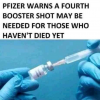Pandemic threat? Anyone else concerned?
- Thread starter erkme73
- Start date
You are using an out of date browser. It may not display this or other websites correctly.
You should upgrade or use an alternative browser.
You should upgrade or use an alternative browser.
bigredfish
Known around here

Criminal Malfeasance: Pfizer Knew 275 People Suffered Serious Strokes in the First 90 Days After Vaccine Rollout - DailyClout
Pfizer’s conclusion: “This cumulative case review does not raise new safety issues.”dailyclout.io
And how many more, like my otherwise healthy active mother who had a major stroke 4 days after jab# 2 in March of ‘21
When I questioned her doctors, they each denied the jab could have such affect. How many more had similar reactions that were never associated to the clot shot?
bigredfish
Known around here
Jim Quinn: It's Not A Lie If You Believe It
 www.zerohedge.com
www.zerohedge.com

ZeroHedge
ZeroHedge - On a long enough timeline, the survival rate for everyone drops to zero

bigredfish
Known around here
Effectiveness of the Coronavirus Disease 2019 (COVID-19) Bivalent Vaccine
Effectiveness of the Coronavirus Disease 2019 (COVID-19) Bivalent Vaccine
Posted December 19, 2022.
Summary Among 51011 working-aged Cleveland Clinic employees, the bivalent COVID-19 vaccine booster was 30% effective in preventing infection, during the time when the virus strains dominant in the community were represented in the vaccine.
Effectiveness of the Coronavirus Disease 2019 (COVID-19) Bivalent Vaccine
Posted December 19, 2022.
Summary Among 51011 working-aged Cleveland Clinic employees, the bivalent COVID-19 vaccine booster was 30% effective in preventing infection, during the time when the virus strains dominant in the community were represented in the vaccine.
Oceanslider
Known around here
30% within what timeframe? Do I read 30% within 90 days?Effectiveness of the Coronavirus Disease 2019 (COVID-19) Bivalent Vaccine
Effectiveness of the Coronavirus Disease 2019 (COVID-19) Bivalent Vaccine
Posted December 19, 2022.
Summary Among 51011 working-aged Cleveland Clinic employees, the bivalent COVID-19 vaccine booster was 30% effective in preventing infection, during the time when the virus strains dominant in the community were represented in the vaccine.
bigredfish
Known around here
Oceanslider
Known around here
I will never be able to get the leftist mantra out of my thoughts when this all started…
”Just one life!” As if they were the champions for ever single life.
what happened?
And how many more, like my otherwise healthy active mother who had a major stroke 4 days after jab# 2 in March of ‘21
When I questioned her doctors, they each denied the jab could have such affect. How many more had similar reactions that were never associated to the clot shot?
I thought of you and your mom after posting this, I feel bad because I know this really hits close to home for you.
bigredfish
Known around here
No need to feel bad sir. The facts are the facts, I've obviously been following it closer than many for that reason. You didnt tell her to get the shot, and neither did I. Few if any knew what was going on back in Jan-March of '21. Unfortunately those that did, our trusted government officials and Pharma companies, DID know ,and went ahead with the propaganda campaign anyway. They are at fault.
bigredfish
Known around here
30% within what timeframe? Do I read 30% within 90 days?
Yes the study was from 12th Sept through 12th December 2022
Full study here https://www.medrxiv.org/content/10.1101/2022.12.17.22283625v1.full.pdf
Excerpts: Highlights in bold by me
--------
Statistical analysis
A Simon-Makuch hazard plot [12] was created to compare the cumulative incidence of COVID-19
in the bivalent vaccinated and non-vaccinated states, by treating bivalent vaccination as a time-dependent
covariate. Individuals were considered bivalent vaccinated 7 days after receipt of a single dose of the
bivalent COVID-19 vaccine. Subjects who had not developed COVID-19 were censored at the end of the
study follow-up period. Those whose employment was terminated during the study period before they had
COVID-19 were censored on the date of termination of employment. Curves for the non-vaccinated state
were based on data while the bivalent vaccination status of subjects remained “non-vaccinated”. Curves
for the bivalent vaccinated state were based on data from the date the bivalent vaccination status changed
to “vaccinated”.
Multivariable Cox proportional hazards regression models were fitted to examine the association
of various variables with time to COVID-19. Bivalent vaccination was included as a time-dependent
covariate [13]. The primary model included all study subjects. The secondary model included only those
with prior exposure to SARS-CoV-2 by infection or vaccination. Vaccine effectiveness was calculated
from the hazard ratios for bivalent vaccination in the models.
The analysis was performed by N. K. S. and A. S. N. using the survival package and R version
4.2.2 (R Foundation for Statistical Computing) [13–15].
RESULTS
Of 51977 eligible subjects, 966 (1.9%) were excluded because of missing age or gender. Of the
remaining 51011 employees included in the study, 34507 (68%) had been in employment since before the
onset of the COVID-19 pandemic (pre-pandemic hires). 1794 subjects (3.5%) were censored during the
study period because of termination of employment before the end of the study. By the end of the study,
10804 (21%) were bivalent vaccine boosted. The bivalent vaccine was the Pfizer vaccine in 9595 (89%)
and the Moderna vaccine in the remaining 1178. Altogether, 2452 employees (5%) acquired COVID-19
during the 13 weeks of the study.
Baseline characteristics
Table 1 shows the characteristics of subjects included in the study. Notably, this was a relatively
young population, with a mean age of 42 years. Among these, 20689 (41%) had previously had a
documented episode of COVID-19 and 12029 (24%) had previously had an Omicron variant infection.
44592 subjects (87%) had previously received at least one dose of vaccine, 42064 (83%) had received two
doses, 27254 (53%) had received at least three doses, and 3858 (8%) had received four or more doses.
46340 (91%) had been previously exposed to SARS-CoV-2 by infection or vaccination.
Risk of COVID-19 based on prior infection and vaccination history
The risk of COVID-19 varied by the phase of the epidemic in which the subject’s last prior
COVID-19 episode occurred. In decreasing order of risk of COVID-19 were those never previously
infected, those last infected during the pre-Delta or Delta phase, those last infected during the Omicron
BA.1/BA.2 phase, and those last infected during the Omicron BA.4/BA.5 phase (Figure 1).
The risk of COVID-19 also varied by the number of COVID-19 vaccine doses previously
received. The higher the number of vaccines previously received, the higher the risk of contracting
COVID-19 (Figure 2).
Bivalent vaccine effectiveness
In a multivariable Cox proportional hazards regression model adjusted for age, gender, hire cohort,
job category, number of COVID-19 vaccine doses prior to study start, and epidemic phase when the last
prior COVID-19 episode occurred, a bivalent vaccine provided some protection against COVID-19 (HR,
.70; 95% C.I., .61-.80; P-value, <.001). Point estimates and 95% confidence intervals for hazard ratios for
the variables included in the unadjusted and adjusted Cox proportional hazards regression models are
shown in Table 2. The calculated overall vaccine effectiveness from the model was 30% (95% C.I., 20% –
39%).
The multivariable analyses also found that, the more recent the last prior COVID-19 episode was
the lower the risk of COVID-19, and that the greater the number of vaccine doses previously received the
higher the risk of COVID-19.
Bivalent vaccine effectiveness among those with prior SARS-CoV-2 infection or vaccination
Given that both natural immunity and vaccine-induced immunity protect against COVID-19, and
both forms of immunity wane over time, one way to assess the effectiveness of a vaccine is to adjust for
time since the proximate SARS-CoV-2 exposure by infection or vaccination.
Among persons with prior exposure to SARS-CoV-2 by infection or vaccination, hazard ratios for bivalent vaccination for
individuals, after adjusting for time since proximate SARS-CoV-2 exposure, are shown in table 3. This
analysis shows that, in addition to a 21% protective effect of bivalent vaccination, those with last exposure
to SARS-CoV-2 6-9 months previously have twice the risk, and those exposed 9-12 months previously
have 3.5 times the risk, of COVID-19, compared to those with last exposure within the preceding 90 days
......
Another study found that receipt of two or three doses of a mRNA vaccine following prior COVID-19 was
associated with a higher risk of reinfection than receipt of a single dose [7]. We still have a lot to learn
about protection from COVID-19 vaccination, and in addition to a vaccine’s effectiveness it is important to
examine whether multiple vaccine doses given over time may not be having the beneficial effect that is
generally assumed.
In conclusion, this study found an overall modest protective effect of the bivalent vaccine booster
against COVID-19, among working-aged adults. The effect of multiple COVID-19 vaccine doses on future
risk of COVID-19 needs further study
Fill me in on these stats......
I've been known to take dexamethazone whenever I have a respritory issue, the stuff works wonders on poison ivy. Last year one of our kids had croup and we gave it to them instead of a expensive steroid pack from the pharmacy.
I consider it the miracle drug. I have at least 2 bottles in my med cabinet at all times. It is one of my most used meds for our sheep and hogs. It also cures a lot of my ailments. Plus it's cheap from my vet, a 100ml bottle is under $5.
I get laughed at from guys at work because I'll quicker goto my med cabinet for our livestock rather than the pharmacy.
I ask them who they trust more, the media, government and big pharma or a vet. It's almost as if a light bulb went off in their head.
I ask them who they trust more, the media, government and big pharma or a vet. It's almost as if a light bulb went off in their head.
bigredfish
Known around here
Fill me in on these stats......
I've been known to take dexamethazone whenever I have a respritory issue, the stuff works wonders on poison ivy. Last year one of our kids had croup and we gave it to them instead of a expensive steroid pack from the pharmacy.
I consider it the miracle drug. I have at least 2 bottles in my med cabinet at all times. It is one of my most used meds for our sheep and hogs. It also cures a lot of my ailments. Plus it's cheap from my vet, a 100ml bottle is under $5.
Thats just the data reported to the FDA and CDC adverse events database. Thats over 16 years.
I get laughed at from guys at work because I'll quicker goto my med cabinet for our livestock rather than the pharmacy.
I ask them who they trust more, the media, government and big pharma or a vet. It's almost as if a light bulb went off in their head.
Yeah and don't forget that "horse paste" Ivermectin.
 Good thing my shot only contained saline. Moving on!
Good thing my shot only contained saline. Moving on! I never came anywhere near their so-called 'vaccine', so I hope to be around at least another 15 to 20 years.
bigredfish
Known around here
It’s because of global warming. Wait for it …





